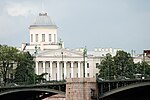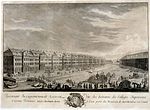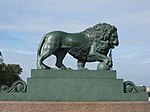Old Saint Petersburg Stock Exchange and Rostral Columns
Buildings and structures in Saint PetersburgCommercial buildings completed in 1810Greek Revival buildingsNeoclassical architecture in RussiaStock exchange buildings

The Old Saint Petersburg Stock Exchange (also Bourse) and Rostral Columns, located in Saint Petersburg in the Russian Federation, are significant examples of Greek Revival architecture. Designed by French architect Thomas de Thomon, and inspired by the Greek Temple of Hera at Paestum, the stock exchange was constructed between 1805 and 1810. The rostral columns erected on either side of the Stock Exchange were completed in 1811. The Old Saint Petersburg Stock Exchange is located at Birzhevaya Ploschad 4.
Excerpt from the Wikipedia article Old Saint Petersburg Stock Exchange and Rostral Columns (License: CC BY-SA 3.0, Authors, Images).Old Saint Petersburg Stock Exchange and Rostral Columns
Birzhevaya Square, Saint Petersburg
Geographical coordinates (GPS) Address Nearby Places Show on map
Geographical coordinates (GPS)
| Latitude | Longitude |
|---|---|
| N 59.943333333333 ° | E 30.304444444444 ° |
Address
Санкт-Петербургская Биржа
Birzhevaya Square 4
199034 Saint Petersburg (округ № 7)
Saint Petersburg, Russia
Open on Google Maps











